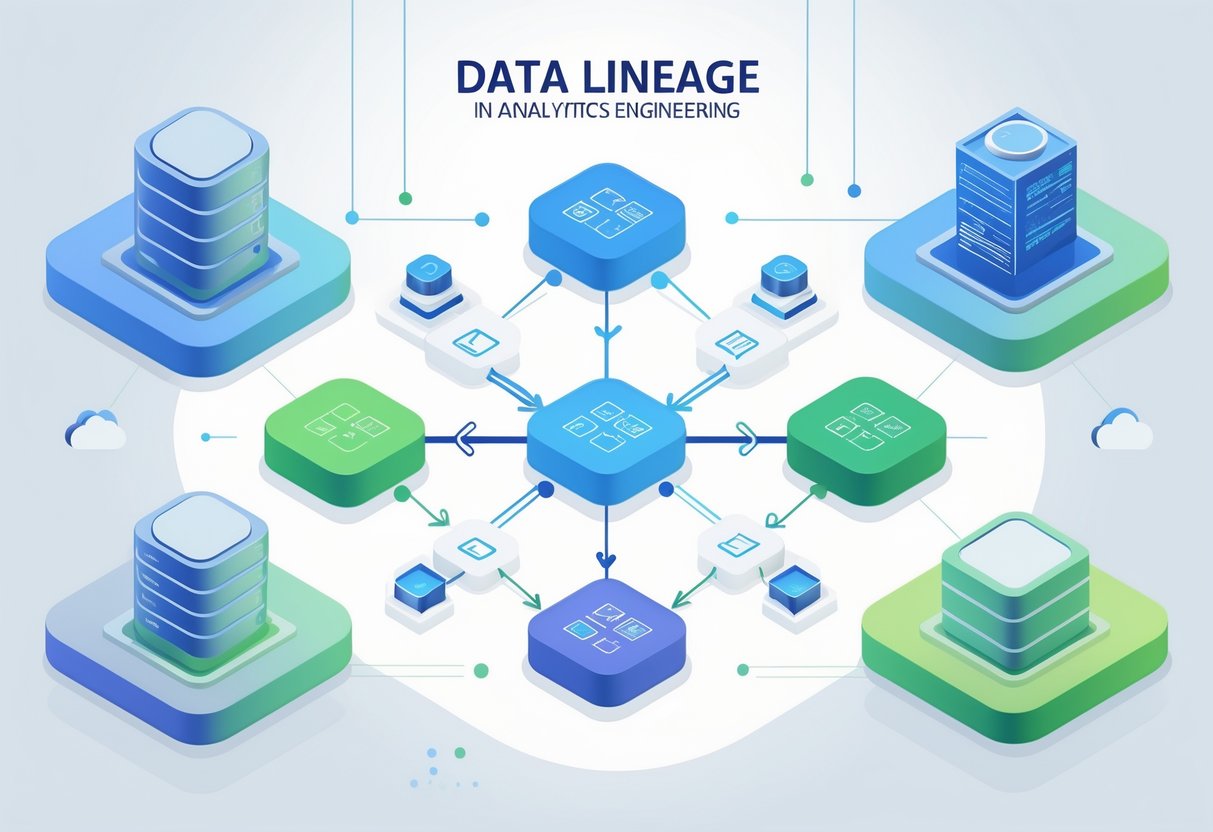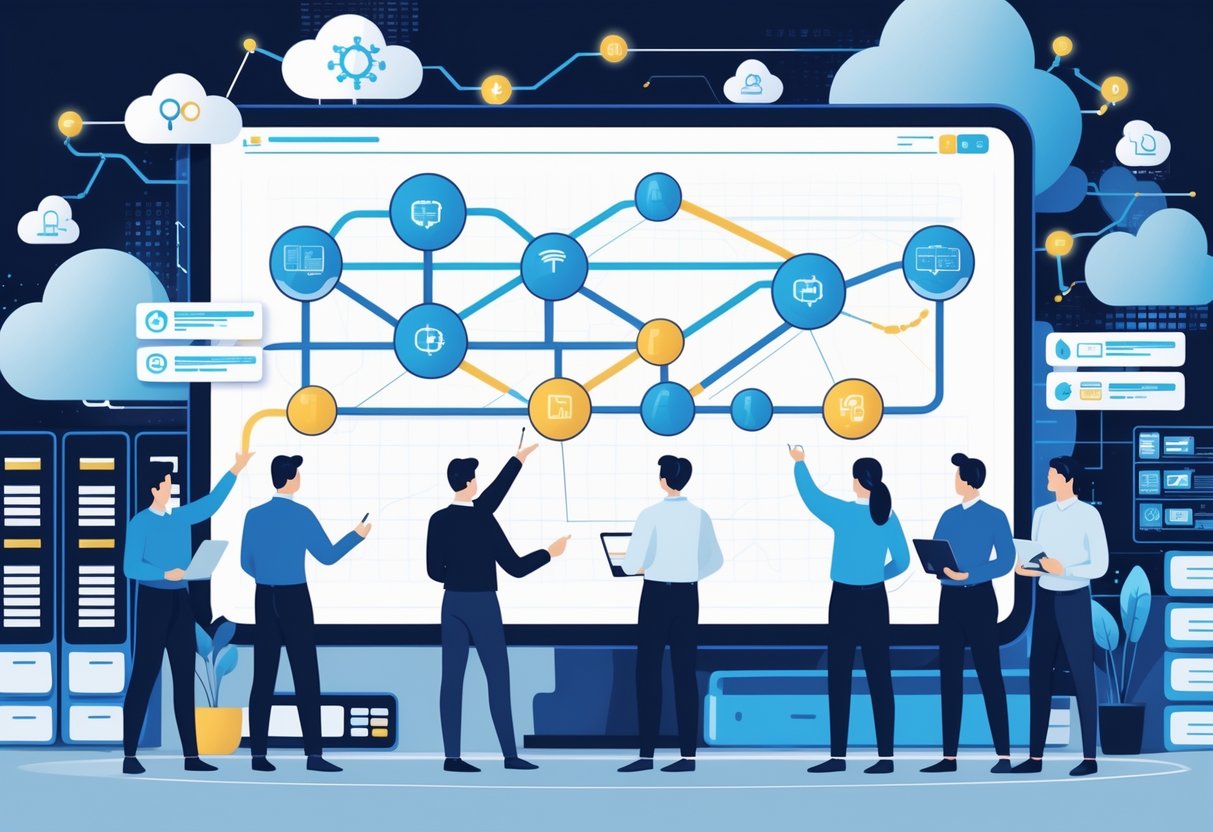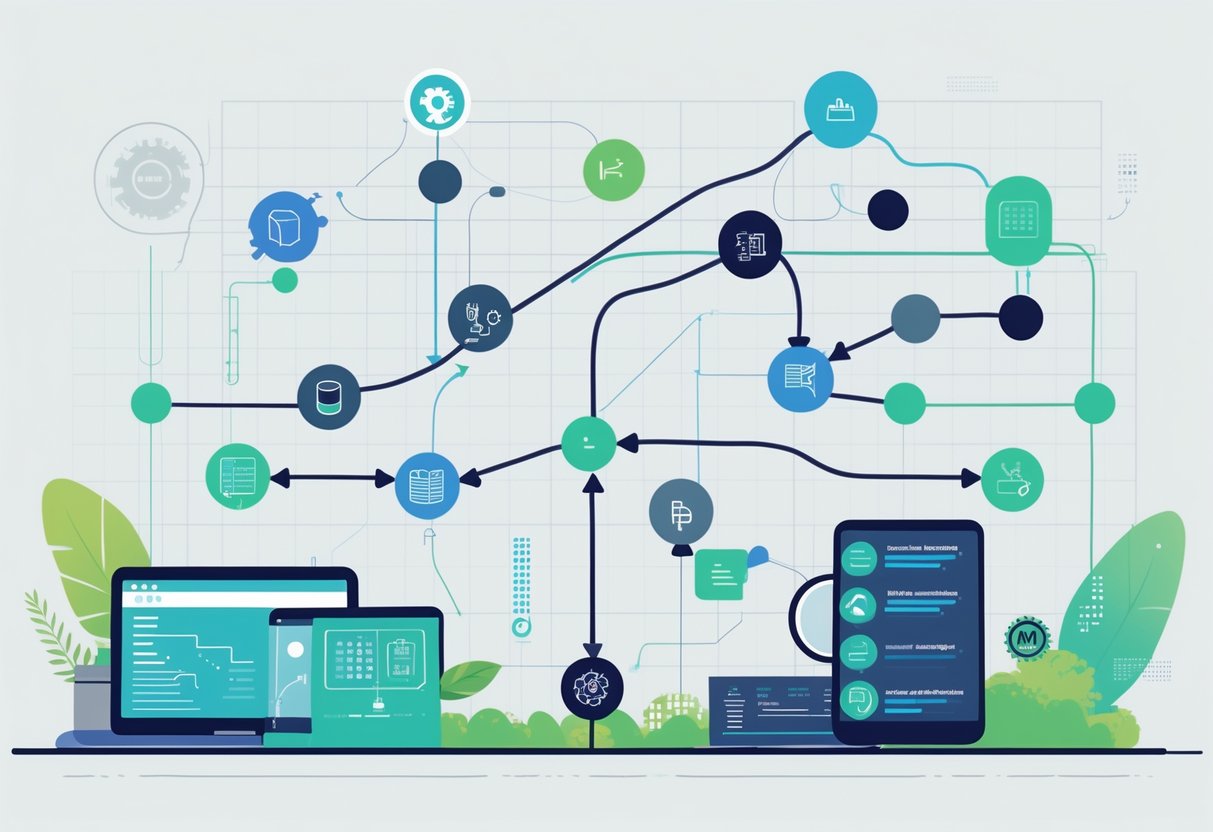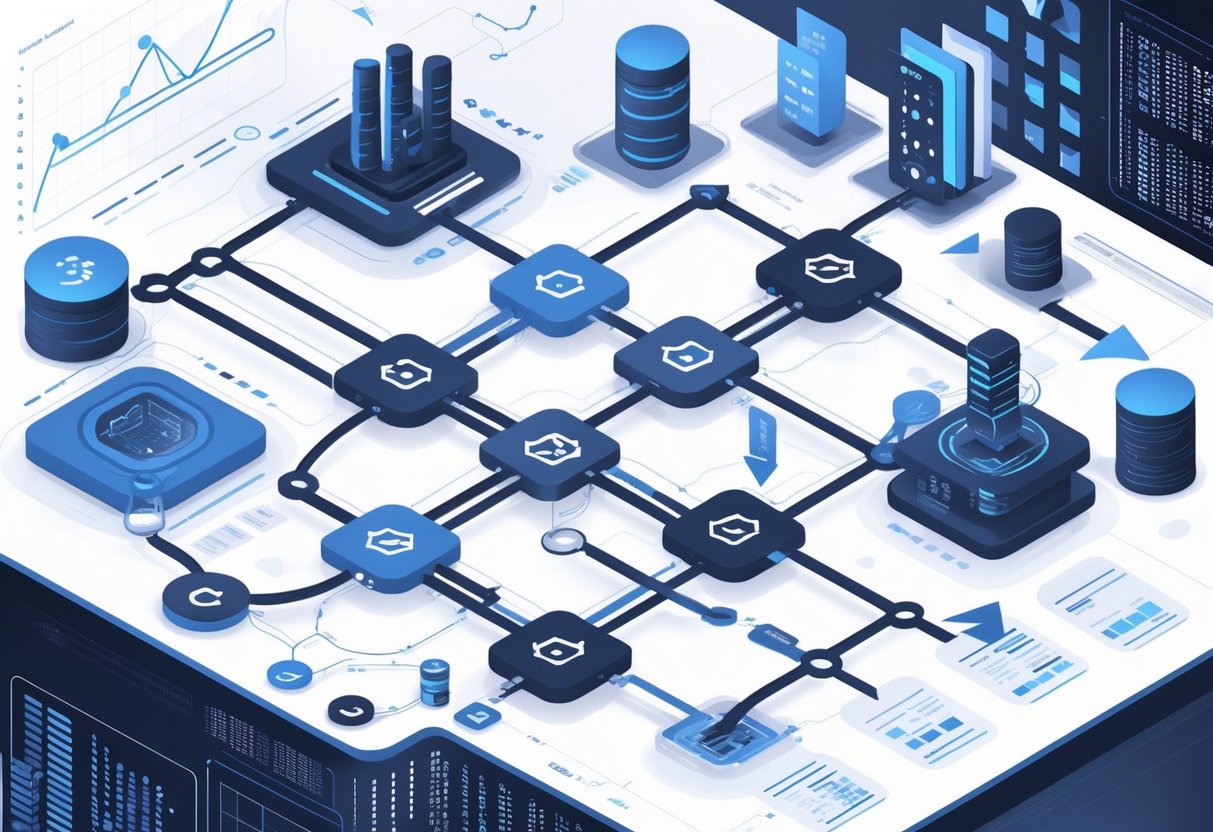Modern analytics engineers face a constant challenge: understanding where their data comes from and how it transforms through complex pipelines. As data flows through multiple systems, tools, and transformations, tracking its journey becomes critical for building reliable analytics and maintaining data quality.

Data lineage provides analytics engineers with a complete map of data’s journey from source to destination, showing every transformation, movement, and dependency along the way. This visibility enables teams to debug issues faster, ensure compliance, and build trust in their analytics outputs. Data lineage acts like Google Maps for data, giving analysts a clear view of how information moves through their architecture.
Analytics engineers who master data lineage gain powerful capabilities for impact analysis, troubleshooting, and governance. This guide explores the essential concepts, tools, and best practices that transform data lineage from a nice-to-have into a competitive advantage for analytics teams working with increasingly complex data ecosystems.
Key Takeaways
- Data lineage tracks the complete journey of data from its origin through all transformations to its final destination
- Analytics engineers use lineage tools to quickly debug issues, analyze impacts of changes, and ensure data quality
- Implementing effective data lineage requires the right combination of automated tools, visualization capabilities, and organizational best practices
Understanding Data Lineage in Analytics Engineering

Data lineage tracks the complete journey of data from its original sources through transformations to final destinations. Analytics engineers use lineage to map data flow paths, understand dependencies between datasets, and maintain visibility across complex data ecosystems throughout the entire data lifecycle.
What Data Lineage Is
Data lineage represents the complete pathway that data follows as it moves through an organization’s systems. It captures every step from initial data creation to final consumption in reports and dashboards.
Data lineage tracking describes the flow of data from its origin to its destination, covering every transformation, migration, and integration that occurs along the way. This creates a detailed map of how information travels through the data ecosystem.
The lineage includes three main elements: data sources where information originates, transformations that modify or process the data, and destinations where the final results are stored or displayed. Each step in this journey gets documented to create a complete picture.
Analytics engineers rely on this documentation to understand how changes in one system might affect downstream processes. When a database update occurs, lineage shows exactly which reports, dashboards, or models will be impacted.
This visibility becomes critical when troubleshooting data quality issues or explaining how specific metrics get calculated to business stakeholders.
Key Concepts and Definitions
Several core concepts form the foundation of data lineage in analytics engineering. Understanding these terms helps engineers communicate effectively about data flow and dependencies.
Data flow refers to the movement of information between systems, applications, and processes. It shows the direction and sequence of data transfers throughout the organization.
Data lifecycle encompasses all stages that data experiences, from initial collection through processing, storage, analysis, and eventual archival or deletion. Each stage presents opportunities to track lineage.
Data management involves the practices and technologies used to collect, store, organize, and maintain data assets. Effective data lineage supports better data governance and quality control within these management processes.
Dependencies represent relationships between different data assets. When one dataset depends on another, changes upstream can affect downstream results.
Metadata provides information about data characteristics, including creation dates, data types, transformation rules, and business definitions. This metadata becomes part of the lineage documentation.
Types of Data Lineage
Analytics engineers work with different types of lineage depending on their specific needs and the level of detail required for their projects.
Business lineage focuses on high-level data relationships that matter to business users. It shows how key metrics and reports connect to major data sources without getting into technical details.
Technical lineage provides detailed information about database tables, columns, transformation logic, and system-level processes. This granular view helps engineers debug issues and optimize performance.
Operational lineage captures real-time data movement and processing activities. It shows which jobs ran when, how long they took, and whether they completed successfully.
Forward lineage traces data from sources to destinations, answering questions about where specific information ends up. Backward lineage works in reverse, showing where final results originated.
Some organizations use automated lineage tools that discover relationships by analyzing code and system logs. Others rely on manual lineage documentation that engineers create and maintain themselves.
The choice between these approaches depends on the complexity of the data ecosystem and the resources available for lineage management.
The Importance of Data Lineage for Analytics Engineers

Analytics engineers rely on data lineage to build trustworthy data systems and meet business requirements. Data lineage provides transparency into data flows, improves data quality through better debugging capabilities, and ensures organizations meet regulatory standards.
Ensuring Data Trust and Transparency
Data lineage creates a clear map of how data moves through systems. Analytics engineers can trace any data point back to its original source. This visibility helps teams understand what transformations happened to the data.
When stakeholders question data accuracy, analytics engineers can quickly show the data’s journey. They can explain which systems processed the data and what changes occurred at each step.
Key transparency benefits include:
- Complete visibility into data transformations
- Clear documentation of data sources
- Easy identification of data dependencies
- Better communication with business users
Understanding data lineage helps build trust in analytics by showing exactly how reports and dashboards get their information. Business users feel more confident making decisions when they understand where their data comes from.
Analytics engineers can also perform impact analysis before making changes. They can see which downstream reports or models will be affected by pipeline modifications.
Driving Data Quality and Data Governance
Data lineage makes debugging faster and more effective. When data quality issues appear, analytics engineers can trace problems back to their source quickly.
Data lineage helps identify the root cause of data quality problems by showing each transformation step. Engineers can pinpoint whether issues started in source systems or occurred during processing.
Data governance improvements include:
- Faster issue resolution
- Better data validation processes
- Clearer ownership responsibilities
- Improved change management
Data governance teams use lineage to establish clear data ownership. They can assign responsibility for different data assets and ensure proper maintenance procedures exist.
Analytics engineers can also validate that data transformations follow business rules. They can check that sensitive data gets properly masked or encrypted during processing.
The lineage documentation becomes part of the data governance framework. It provides the foundation for data cataloging and metadata management initiatives.
Supporting Regulatory Compliance
Modern regulations require organizations to track how they collect, process, and store data. Analytics engineers must document these processes to meet compliance requirements.
GDPR, HIPAA, and SOX require complete records of data processing activities. Data lineage provides the audit trails needed to demonstrate compliance during regulatory reviews.
Compliance requirements addressed:
| Regulation | Key Requirement | How Lineage Helps |
|---|---|---|
| GDPR | Data processing transparency | Shows how personal data flows through systems |
| HIPAA | Protected health information tracking | Documents healthcare data transformations |
| SOX | Financial data accuracy | Provides audit trails for financial reporting data |
Analytics engineers can quickly generate compliance reports using lineage data. They can show auditors exactly how sensitive data moves through the organization.
Data lineage also supports data subject requests under GDPR. Engineers can identify all systems that process an individual’s personal data. This makes it easier to fulfill deletion or portability requests.
The automated tracking capabilities reduce manual compliance work. Analytics engineers can set up systems that continuously monitor data flows and generate required documentation.
How Data Lineage Works: Process and Components

Data lineage tracks data movement from its starting point through various systems and transformations to its final destination. The process involves capturing metadata from source systems, monitoring data pipelines, and creating visual maps that show complete data flows.
Data Origin and Capture
Data lineage begins by identifying where information first enters an organization’s systems. Source systems include databases, APIs, files, and external data feeds that create the foundation of all downstream analytics.
Modern lineage tools automatically scan these systems to capture metadata. They collect information about table structures, column definitions, and data types without manual intervention.
The capture process also records timestamps and user information. This creates a complete record of when data entered the system and who was responsible for the initial data creation.
Key capture points include:
- Database tables and views
- API endpoints and webhooks
- File uploads and batch imports
- Real-time streaming data sources
Analytics engineers benefit from automated capture because it eliminates the need to manually document every data entry point. The system continuously monitors for new sources and updates the lineage map in real-time.
Tracking Data Movement and Transformation
Once data enters the system, lineage tools monitor how it moves through data pipelines. They analyze SQL queries, transformation scripts, and data processing jobs to understand each step.
Column-level lineage provides granular visibility into how individual data elements change as they flow through systems. This detailed tracking shows exactly which source columns contribute to each output field.
Transformation tracking captures multiple types of changes:
| Transformation Type | Description | Example |
|---|---|---|
| Aggregation | Combining multiple rows | SUM, COUNT, AVG functions |
| Filtering | Removing specific records | WHERE clauses |
| Joining | Combining data from multiple tables | INNER, LEFT, RIGHT joins |
| Calculations | Creating new derived fields | Mathematical operations |
The tracking process also monitors data quality rules and validation steps. When transformations fail or produce unexpected results, engineers can quickly identify which pipeline stage caused the issue.
End-to-End Data Flow Mapping
The final component creates visual representations of complete data journeys. These maps show connections between source systems, transformation processes, and final consumption points like dashboards or reports.
Data flow mapping traces paths from source through various systems to provide comprehensive views of data movement. Interactive diagrams allow users to click on any element and see its complete upstream and downstream connections.
Modern mapping tools display both table-level and field-level relationships. Users can zoom out to see high-level data flows or drill down to examine specific column dependencies.
Essential mapping features include:
- Interactive visualization with zoom and filter capabilities
- Impact analysis showing downstream effects of changes
- Dependency tracking for understanding data relationships
- Integration with existing data catalogs and documentation
The mapping process updates automatically as data pipelines change. When engineers modify transformation logic or add new data sources, the lineage map reflects these changes without manual updates.
These visual maps become essential tools for troubleshooting data issues and planning system changes. Engineers can quickly assess the impact of proposed modifications before implementing them in production environments.
Data Lineage Tools and Technologies

Modern analytics engineers have access to automated tools that extract lineage from code and queries, comprehensive data catalogs that manage metadata across systems, and both open source and commercial solutions that integrate seamlessly with existing data platforms.
Automated Data Lineage Tools
Automated data lineage tools scan systems and extract metadata to map data flows without manual documentation. These tools parse SQL queries, ETL jobs, and configuration files to detect how data moves between systems.
Seemore Data provides multilayered deep lineage with cost optimization insights. The platform offers real-time recommendations and connects to major data warehouses like Snowflake and BigQuery.
Collibra uses AI to improve automated lineage accuracy. It provides root cause analysis and inline code context for data transformations within lineage diagrams.
Informatica automates lineage extraction across data pipelines and derives lineage from SQL scripts and stored procedures. The tool offers end-to-end visibility from system to column level.
These automated solutions scale with growing data volumes. They continuously update lineage maps as infrastructure changes occur.
Data Catalogs and Metadata Management Solutions
Data catalogs centralize metadata and business context alongside technical lineage information. Metadata management captures data definitions, owners, formats, and quality metrics across disparate systems.
Alation overlays business metadata onto technical data flows. It provides data health indicators and trust flags within lineage diagrams for improved transparency.
Microsoft Purview integrates metadata management with Azure services. The platform provides automated discovery and classification of sensitive data elements.
Atlan offers column-level lineage with automated SQL parsing. It provides a Figma-like interface for exploring data relationships and dependencies.
Modern data catalogs include search capabilities and business glossaries. They enable both technical and non-technical users to understand data context and meaning.
Open Source and Commercial Tool Comparison
| Tool Type | Examples | Key Benefits | Considerations |
|---|---|---|---|
| Open Source | Apache Atlas, OpenLineage, Spline | Cost-effective, customizable, community support | Requires technical expertise, limited support |
| Commercial | Collibra, Informatica, Alation | Enterprise features, vendor support, faster deployment | Higher costs, vendor lock-in potential |
Apache Atlas provides metadata management for Hadoop environments with classification and tagging capabilities. It includes REST APIs for programmatic access to lineage data.
OpenLineage offers a standardized framework for collecting lineage metadata across different tools. It integrates with Apache Airflow, Spark, and dbt through configurable backends.
Commercial solutions provide pre-built connectors and enterprise security features. They offer faster time-to-value but require significant licensing investments.
Integration with Data Platforms
Modern lineage tools connect seamlessly with cloud data warehouses and processing frameworks. Integration capabilities maximize value by sharing metadata across the entire data ecosystem.
DataHub provides open-source metadata management with support for major data platforms. It offers real-time metadata ingestion and push-based architecture.
Monte Carlo focuses on data observability with lineage tracking capabilities. The platform monitors data quality issues and provides automated incident detection.
Talend integrates lineage with data integration workflows. It tracks transformations within ETL processes and provides impact analysis for pipeline changes.
Amundsen offers table and column-level lineage discovery. The platform integrates with popular data processing frameworks like Airflow and supports multiple metadata backends.
These platforms use APIs and connector libraries to integrate with existing tools. They reduce data silos and accelerate return on investment for analytics teams.
Building and Visualizing Data Lineage

Analytics engineers need practical tools to map data flows and track dependencies across their systems. Modern visualization techniques transform complex data relationships into clear diagrams that teams can navigate and understand quickly.
Lineage Maps and Diagrams
Lineage maps show how data moves from source systems through transformations to final outputs. These visual representations display tables, columns, and dependencies as connected nodes in a network diagram.
Analytics engineers typically build these maps using automated tools that scan SQL code and database schemas. The tools parse transformation logic and create visual connections between upstream and downstream assets.
Key elements include:
- Source tables and files
- Transformation steps and business logic
- Target tables and data models
- Column-level dependencies
Most data lineage visualization tools generate these maps automatically by analyzing metadata from data warehouses and transformation code. Engineers can then annotate the diagrams with business context and ownership information.
The maps help identify impact areas when making schema changes. They also reveal data quality issues by showing where problems might cascade through dependent systems.
Data Lineage Visualization Techniques
Graph-based visualizations represent the most common approach for displaying data lineage. Nodes represent data assets while edges show relationships and data flow directions.
Interactive features enhance usability:
- Zoom and pan capabilities for large datasets
- Filter options to focus on specific data domains
- Search functionality to locate particular tables or columns
- Color coding to indicate data freshness or quality status
Some teams prefer hierarchical tree views that show parent-child relationships clearly. Others use swimlane diagrams to group assets by business domain or system ownership.
Modern visualization approaches include temporal views that show how lineage changes over time. These help track the evolution of data pipelines and identify when dependencies were introduced.
Column-level lineage provides the most detailed view. It traces individual fields through joins, calculations, and aggregations to show exactly how values are derived.
Interactive Dashboards for Analytics Teams
Interactive dashboards give analytics teams self-service access to lineage information without requiring technical expertise. These interfaces combine visual lineage maps with metadata search and impact analysis features.
Teams can explore lineage by clicking through connected assets or using search functions to find specific datasets. The dashboards often integrate with existing tools like data catalogs and workflow orchestrators.
Common dashboard features include:
- Real-time lineage updates as pipelines execute
- Integration with data quality monitoring systems
- Collaboration tools for adding comments and documentation
- Alert systems for downstream impact notifications
Many platforms offer collaborative features that allow different teams to share lineage views and coordinate changes. Analytics engineers can mark critical paths and set up notifications when upstream changes affect important reports.
The dashboards typically connect to data warehouses and data lakes through APIs. This ensures lineage information stays current as schemas and transformations evolve.
Best Practices and Challenges in Data Lineage Implementation

Teams face critical decisions between manual and automated approaches while managing complex data architectures and ensuring security compliance. Metadata gaps and dynamic system changes create ongoing operational challenges that require strategic solutions.
Manual Versus Automated Documentation
Manual documentation gives teams complete control over lineage mapping but creates significant operational overhead. Analytics engineers must document every data transformation, source connection, and pipeline change by hand.
This approach works well for small teams with simple data flows. Manual processes ensure accuracy when teams have deep knowledge of their systems. Engineers can capture business context that automated tools might miss.
However, manual documentation becomes unsustainable as data architectures grow. Teams struggle to keep records current when dealing with hundreds of data sources and transformations.
Automated data lineage tools extract metadata directly from systems and pipelines. These tools track data movement in real-time without human intervention.
Key benefits of automation include:
- Consistent audit trails across all systems
- Immediate updates when pipelines change
- Reduced human error in documentation
- Better operational efficiency for large teams
Starting small with high-priority datasets allows teams to test automated approaches before full deployment.
Handling Complexity in Modern Data Architectures
Modern data stacks include dozens of tools that process data across cloud platforms, databases, and analytics systems. Each tool creates its own metadata format and connection method.
Multi-cloud environments make lineage tracking even harder. Data might flow from AWS S3 to Google BigQuery through Snowflake transformations. Teams need tools that work across different cloud providers.
Common complexity challenges include:
- Microservices architectures with distributed data processing
- Real-time streaming data that changes constantly
- Legacy systems without modern metadata support
- APIs that don’t expose lineage information
Complex data environments require specialized tools that can parse different metadata formats. Teams often need multiple lineage solutions working together.
Debugging becomes critical when lineage spans multiple systems. Engineers need clear visibility into how data moves between different tools and platforms.
Data Privacy and Security Considerations
Lineage systems store sensitive information about data sources, transformations, and business processes. This metadata can reveal confidential business relationships and data handling practices.
Teams must secure lineage metadata with the same rigor as production data. Access controls should limit who can view complete lineage graphs across different business units.
Privacy regulations like GDPR require detailed audit trails showing how personal data moves through systems. Lineage documentation helps teams prove compliance during regulatory reviews.
Security best practices include:
- Role-based access to lineage information
- Encryption of metadata at rest and in transit
- Regular security audits of lineage tools
- Data masking in development environments
Some organizations need separate lineage systems for different security zones. Production lineage data should never be accessible from development or testing environments.
Troubleshooting access issues becomes important when teams can’t see the lineage information they need for their work.
Addressing Metadata Gaps and Dynamic Changes
Legacy systems often lack proper metadata exports, creating blind spots in lineage tracking. Teams must manually bridge these gaps or build custom extraction tools.
Dynamic schema changes break automated lineage tracking when column names or data types change without notice. Systems need mechanisms to detect and handle these modifications.
Common metadata gaps occur in:
- Custom ETL scripts that don’t document transformations
- Third-party APIs without lineage support
- Manual data uploads and file transfers
- Database stored procedures with complex logic
Real-time metadata capture helps teams stay current with system changes. Automated alerts notify engineers when lineage breaks or becomes incomplete.
Change management processes should require lineage updates before deploying new data pipelines. Teams need clear workflows for updating documentation when systems change.
Version control for lineage metadata helps teams track how data architectures evolve over time. This historical view supports troubleshooting and impact analysis during system changes.
Enabling Advanced Analytics Through Data Lineage

Data lineage transforms analytics teams’ ability to conduct thorough impact analysis, support machine learning workflows, and optimize data access patterns. Teams gain precise visibility into data transformations and dependencies that directly improve analytical confidence and operational efficiency.
Impact Analysis and Change Management
Impact analysis capabilities enable analytics engineers to identify exactly which downstream models, dashboards, and reports will be affected by upstream changes. When source systems undergo modifications or data schemas evolve, teams can trace these impacts through their entire pipeline.
Critical Impact Analysis Functions:
- Upstream dependency mapping
- Downstream effect identification
- Change risk assessment
- Pipeline break prediction
Analytics engineers use this visibility to prevent accidental downstream issues when making schema changes. They can see which business-critical dashboards rely on specific data sources before implementing modifications.
The visual representation helps teams communicate change impacts to stakeholders. Business users understand which reports might be temporarily affected during system updates.
Teams also leverage impact analysis for auditing purposes. They can verify that sensitive data flows only to authorized destinations and ensure compliance requirements are met throughout the pipeline.
Supporting Machine Learning and Data Discovery
Advanced analytics support through data lineage boosts confidence in data used for machine learning models. Data scientists can verify that training datasets contain accurate, up-to-date information with clear transformation history.
Machine Learning Benefits:
- Training data validation
- Feature engineering transparency
- Model input verification
- Data quality assurance
Data lineage enables data discovery by showing analysts which datasets exist and how they connect. Teams can identify reusable data assets instead of creating duplicate transformations.
Analytics engineers can trace feature engineering steps back to raw sources. This transparency helps data scientists understand exactly how model inputs were created and transformed.
The lineage documentation helps teams identify the best datasets for specific analytical questions. They can see which tables contain the most complete or recent information for their use cases.
Version control integration ensures that model training data remains reproducible across different development environments.
Optimizing Data Access and API Integration
Data lineage optimizes data access patterns by revealing inefficient queries and redundant data loads. Analytics teams can identify bottlenecks where multiple processes request the same information through different paths.
Access Optimization Features:
- Query pattern analysis
- Redundant load identification
- Performance bottleneck detection
- Resource usage tracking
Teams use lineage information to design better API integration strategies. They can determine which data endpoints are most frequently accessed and optimize those connections for better performance.
The visual mapping helps architects plan data access layers more effectively. They can see which downstream applications need real-time access versus batch updates.
Analytics engineers can streamline data flows by consolidating similar transformations into reusable modules. This reduces compute costs and improves pipeline efficiency.
API consumers benefit from clearer documentation about data freshness and update schedules. They understand exactly when their requested data was last refreshed and through which processes it flowed.
Frequently Asked Questions

Analytics engineers commonly need guidance on practical implementation aspects and technical distinctions when working with data lineage systems. These questions address documentation standards, visual representation methods, organizational rollout strategies, governance integration, and key conceptual differences.
What are the best practices for creating data lineage documentation?
Analytics engineers should automate lineage collection rather than relying on manual documentation processes. Automated tools like OpenLineage, dbt, or built-in warehouse lineage features provide more accurate and up-to-date information.
Teams should focus on high-risk data domains first. This includes personally identifiable information, financial data, and user-facing datasets that require detailed column-level tracking.
Documentation should include both structural metadata like schemas and columns, plus operational metadata such as job runs and timestamps. This combination provides complete visibility into data transformations.
Organizations benefit from integrating lineage checks into CI/CD pipelines. This prevents schema changes that could break downstream models before they reach production.
Self-service interfaces allow analysts and engineers to answer lineage questions independently. This reduces ticket volume and speeds up troubleshooting processes.
Can you provide an example of a data lineage diagram and explain its components?
A typical e-commerce data lineage flow shows: raw.transactions → stg.transactions_clean → mart.revenue_agg → dashboard.weekly_revenue. Each arrow represents a transformation step with specific business logic applied.
The raw layer contains unprocessed transaction data from source systems. This includes all original columns and potential data quality issues like null values or formatting inconsistencies.
The staging layer applies initial cleaning and standardization rules. Common transformations include removing null-price rows, standardizing date formats, and filtering out test transactions.
The mart layer aggregates cleaned data for analytical purposes. Revenue calculations, customer segmentation, and time-based groupings happen at this stage.
The final dashboard layer presents aggregated metrics to business users. This includes weekly revenue totals, growth percentages, and trend visualizations.
What are the steps involved in implementing data lineage within an organization?
Organizations should start by inventorying existing data sources and transformation processes. This baseline assessment identifies which systems generate, modify, or consume data across the enterprise.
The next step involves selecting appropriate lineage tools based on technical requirements. Factors include database compatibility, real-time vs. batch processing needs, and integration capabilities with existing infrastructure.
Teams need to establish metadata collection processes for both automated and manual capture methods. This includes configuring database connectors, API integrations, and code instrumentation where necessary.
Implementation typically begins with pilot projects focusing on critical business processes. This allows teams to validate approaches and refine procedures before full-scale deployment.
Training programs ensure that data teams understand how to interpret and maintain lineage information. This includes both technical training on tools and business context on data usage patterns.
How does data lineage fit into the broader context of data governance?
Data lineage supports regulatory compliance by providing audit trails for frameworks like GDPR, HIPAA, and SOX. Organizations can demonstrate exactly how personal or financial data moves through their systems.
Lineage enables impact analysis before making changes to data structures or processes. Data stewards can identify all downstream dependencies and coordinate updates across affected teams.
Quality monitoring becomes more effective when teams understand data flow paths. Issues can be traced back to root causes rather than treating symptoms at various points in the pipeline.
Access control policies benefit from lineage visibility into data usage patterns. Security teams can identify sensitive data exposure risks and implement appropriate protection measures.
Data governance committees use lineage information to make informed decisions about data architecture changes. This includes evaluating trade-offs between system performance and compliance requirements.
What methodologies are recommended for effective data lineage visualization?
Graph-based visualizations work best for showing complex data relationships and dependencies. Nodes represent data assets while edges show transformation relationships with directional flow indicators.
Interactive interfaces allow users to explore upstream and downstream paths dynamically. Features like filtering, zooming, and path highlighting help manage complexity in large data ecosystems.
Layered views separate different types of metadata for clearer presentation. Technical teams might need column-level details while business users prefer table-level summaries.
Color coding and visual cues communicate important information quickly. Different colors can indicate data sensitivity levels, processing status, or system boundaries.
Search and navigation capabilities help users find specific data assets or trace particular data elements. This includes both text-based search and visual exploration tools.
What is the distinction between data lineage and data mapping in data management?
Data lineage tracks the complete journey that data takes from origin to destination, including all transformations and processes. It provides a historical and ongoing view of data movement through systems.
Data mapping focuses on defining relationships between source and target data structures. This typically involves one-time documentation of how fields in one system correspond to fields in another system.
Lineage captures temporal aspects of data flow including when transformations occur and how data changes over time. Mapping documents structural relationships without necessarily including timing information.
The scope differs significantly between these approaches. Lineage covers end-to-end data flow across multiple systems while mapping often addresses specific integration points or migration projects.
Maintenance requirements vary considerably. Lineage systems need continuous updates as data flows change while mapping documentation may only require updates during system changes or migrations.




